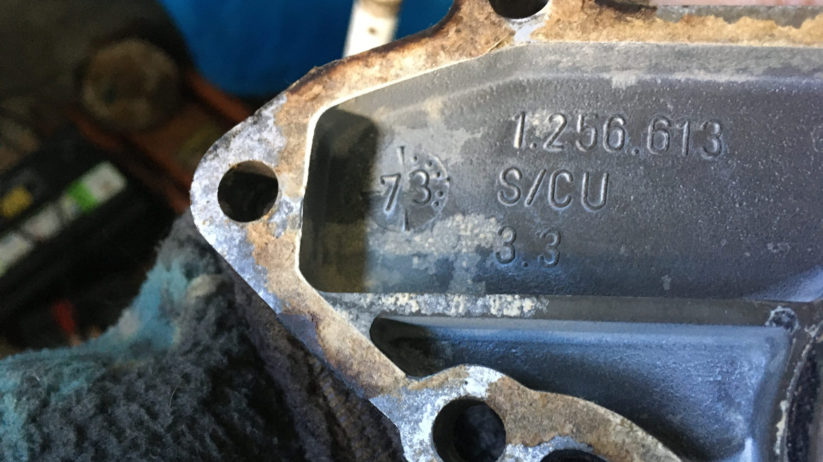When I first inspected Hampton, the 48,000-mile ’73 2002 I bought last September, it was in the barn in Bridgehampton, where it had been sitting for a decade. I checked that the engine wasn’t seized by putting the car in neutral, grabbing the fan blades, putting the heel of my palm on the fan belt, and using the blades and belt to try to rotate the engine. The engine turned freely, but a non-trivial amount of antifreeze immediately began streaming out from under the car, almost certainly from the water-pump bearing and seal. When I briefly started the car a few hours later, it leaked again. Then, after buying the car, towing it home, and doing some light sorting out, I was about to take on its first drive around the block when it did it a third time. However, something in the car must’ve wanted to tease me, because, when I jacked up the car, dried off the coolant, started the engine, and thoroughly inspected the cooling system for the source of the leak, nothing else came out—and the leak never recurred over the 113 miles I’ve driven the car since then.

Hampton marking its territory in my driveway prior to its maiden voyage.
It was likely that the seal in the water pump had been leaking due to its having sat for so long, but with exercise, it had regained some resilience and bounced back. Although I had no plans for a long road trip in the car (part of the problem with owning a 48,000-mile car is that there’s no pretending you won’t affect its value by rolling it over 50,000), it seemed foolish not to replace the water pump. It was really just a question of integrating it into the rhythm of the other work I was doing in the engine compartment. When I’d largely finished cleaning off the old Ziebart undercoating from places I could see, and found that the undercoating extended beneath the radiator, I pulled the radiator out. Clearly the time to replace the water pump had come.
With the radiator out, it was easy to undo the four 10-mm bolts holding the red plastic fan and the pulley to the pump. As sometimes happens, however, the hole in the middle of the plastic fan had a death grip on the pump’s nose. I lubricated it and rocked it, but it wouldn’t budge. I finally took a long screwdriver and pried on the back of the pulley to force the fan off. I was gentle—or so I thought—rotating the pulley around and applying a little pressure at 90-degree increments. Finally the pulley and fan gave it up.
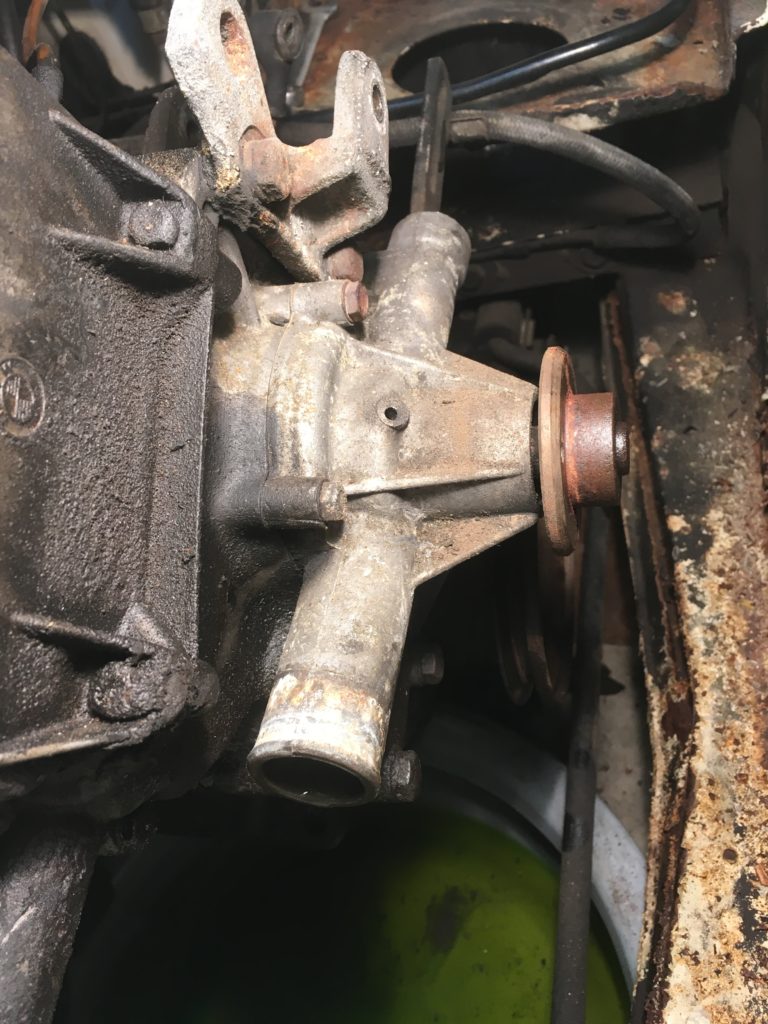
The original water pump. You can see the bit of corrosion on the nose that held the fan and pulley.
From there, it was just removing the three 13-mm and four 10-mm bolts holding the pump to the lower timing cover, and prying the pump off its ancient gasket. What I saw was pretty amazing: The pump displayed a date code of 1973, meaning that it was likely the original unit. There was a little bit of corrosion on the impeller in a straight line, likely at the angle at which it had sat in coolant for a decade. But the bearing felt fine, with no obvious play or crunchiness. I kind of hated to replace it, but it had leaked—three times.
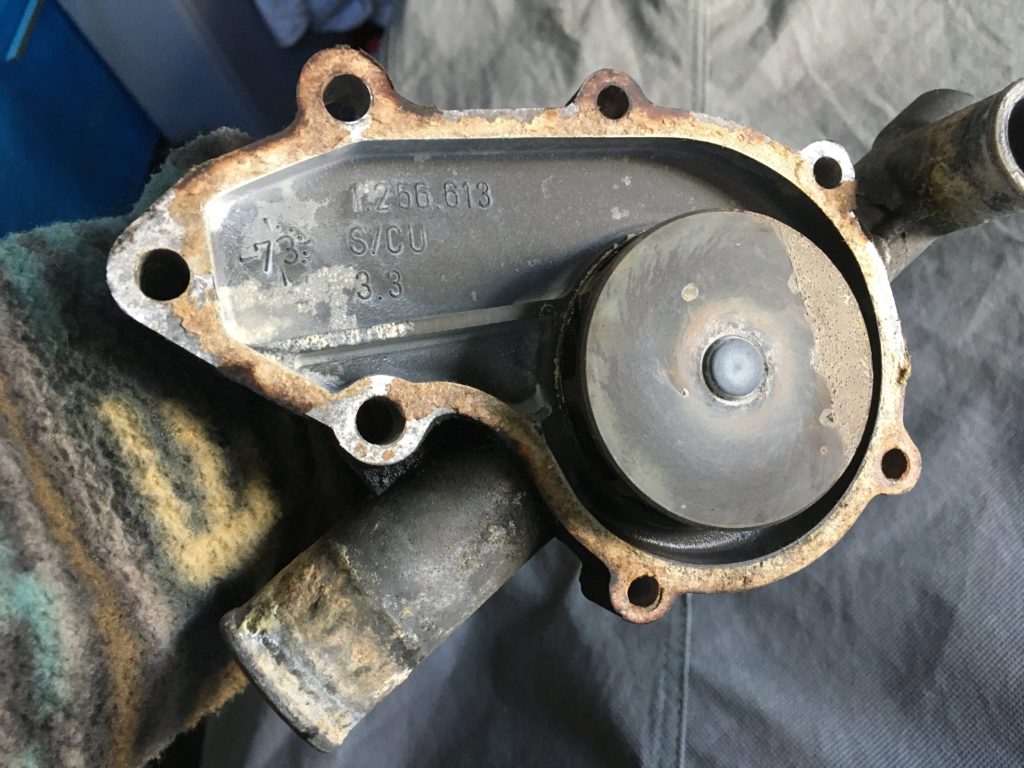
Original!
Instead, I reached for two water pumps I had on the shelf in the garage. One was a Graf pump that I’d bought to install in Bertha but had never gotten around to it. The other was an inexpensive Cardone rebuild that I’d bought years back just to have as a road spare. At the time, it was probably 25 bucks as a closeout from Rockauto. But when I looked at the Cardone pump and saw that it was date-stamped 1969 and still had the BMW logo on the front, it seemed to mesh well with Hampton’s original vibe, so I decided to use it.
First I had to clean off the gasket-mating surface on Hampton’s lower timing cover. Anyone who’s ever had to do this with a pump that’s been on there for 45 years knows that the gasket can sometimes take on the consistency of cement. After scraping with the obligatory single-edged razor blade, I probably spent an hour with the Dremel tool and a little Scotch-Brite wheel cleaning off the surface.
Since we were in the middle of a winter cold spell, I took the rare step of turning on the heat in the garage and leaving it on for two days to warm up the metal. I then gave both sides of the gasket a coating with Permatex Aviation Form-A-Gasket (I’d actually brought it inside the house for two days to warm it up), and installed the pump, hoping that the heat in the garage would help the sealant to cure. At least it would be better than if it was 35 degrees.
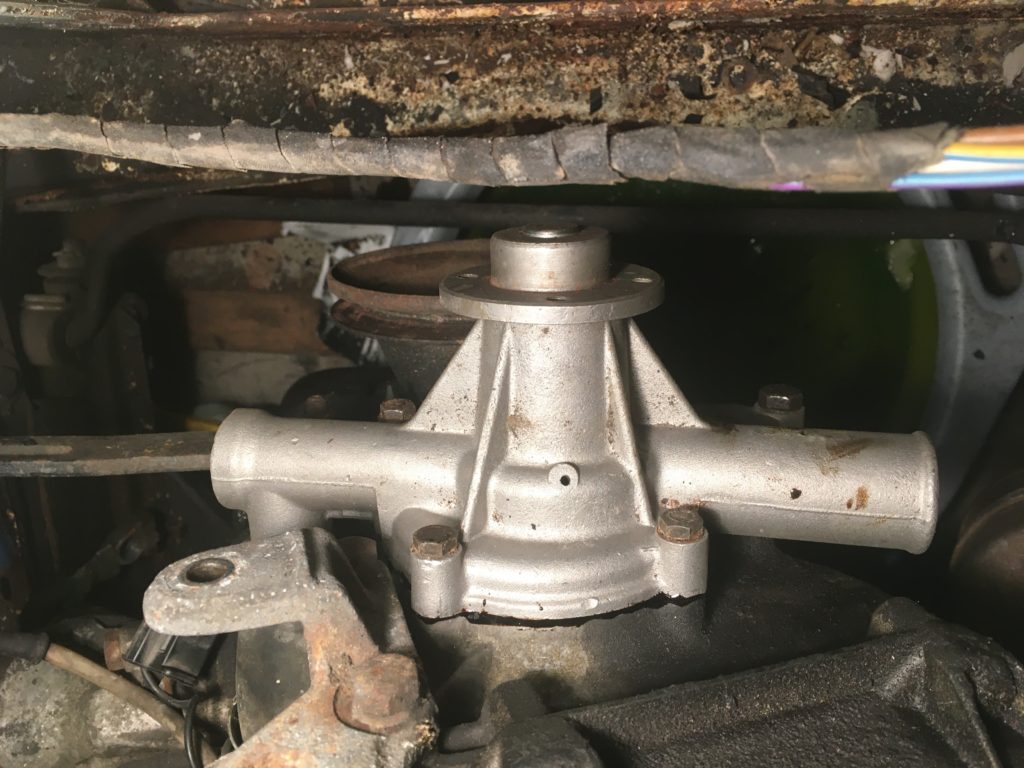
The Cardone rebuilt pump, happily installed. Or is it?
Two days later, I began to reassemble the cooling system. The sealant was a little tackier than I would’ve expected it to be in summer heat, but it was probably fine. I mounted the pulley and fan with the four 10-mm bolts. I was about to install the alternator and fan belt when I reflexively gave the fan a little spin.
The pulley looked bent. I could clearly see it move closer to, and then further from, the neck to the lower radiator hose. Damn! I thought. I must’ve bent it prying it off.
My second thought was that I must have a spare pulley around the garage somewhere. I mean, this is exactly why you hold onto ridiculous numbers of non-wear-and-tear “who’d ever need to replace that?” items like this, right? But to my stunned surprise, a search of the garage, basement, and storage closet yielded no spare pulley.
I looked online and found that the new part is no longer available, and saw none for sale on eBay. Crap, crap, crap, crap, crap!
I texted my friend Paul Wegweiser and told him of my woes. He asked me to measure the pulley to be certain, then replied that, yes, he had one and would send it my way. When it arrived, I quickly installed it. But out of paranoia, I spun the fan, and saw the same thing. What the hell? TWO bent pulleys?
Then I remembered that I had had something similar happen when I was rebuilding the Lotus engine, and found that the problem wasn’t the pulley, it was a bent spindle in the water pump.
I took the original pulley, bolted it onto the original 1973 water pump, held it in my hand, and spun it. I could see a slight bit of out-of-trueness in the pulley, likely from where I’d pried it with a screwdriver, but it was pretty minor. I then bolted on the pulley that Paul had just sent me. It spun dead-nuts straight. So the problem was clearly in the rebuilt Cardone pump.
With no pulley on it, I spun the flange and watched it closely. I could see that the flange itself was bent. Perhaps the spindle was bent as well, but it really didn’t matter. The rebuilt Cardone pump was junk. I removed it, threw it in the garbage, and used some solvent to clean off the still-tacky Form-A-Gasket.
A friend of mine, Justin Gerry (the former owner of Yale Rachlin’s 2002tii that’s at the BMW CCA Foundation), read my Facebook post about my water-pump follies and advised that I might want to talk with Flying Dutchman Water Pumps in Oregon about having the original one rebuilt. This was the sort of thing where, reading it, I really appreciated that bit of info, but thought, “Yeah, I’m not going to do that.” What that meant was, “That’s not the least-expensive alternative. I already have the least-expensive alternative—my already-paid-for spare unused Graf pump. I can throw the original pump in the trunk. If this level of originality is important to the next owner, he or she can make that choice.”
Last night I went back into the garage, pulled the Graf pump down off the shelf where it’s been sitting for a year, took it out of the box, and held it in my hand. My reaction was immediate, visceral, and unequivocal: No!
This isn’t a knock on Graf. I’ve used their water pumps in many cars. I wouldn’t have given this one a second thought if were installing it in Bertha, my ratty resurrected ’75 2002. But for Hampton, well, that’s a different story. The look of the casting, the way the metal felt in my hand… I felt like if I installed it, Hampton would reject it like an organ with non-matching blood and tissue types. No—just no. I put it back in the box.
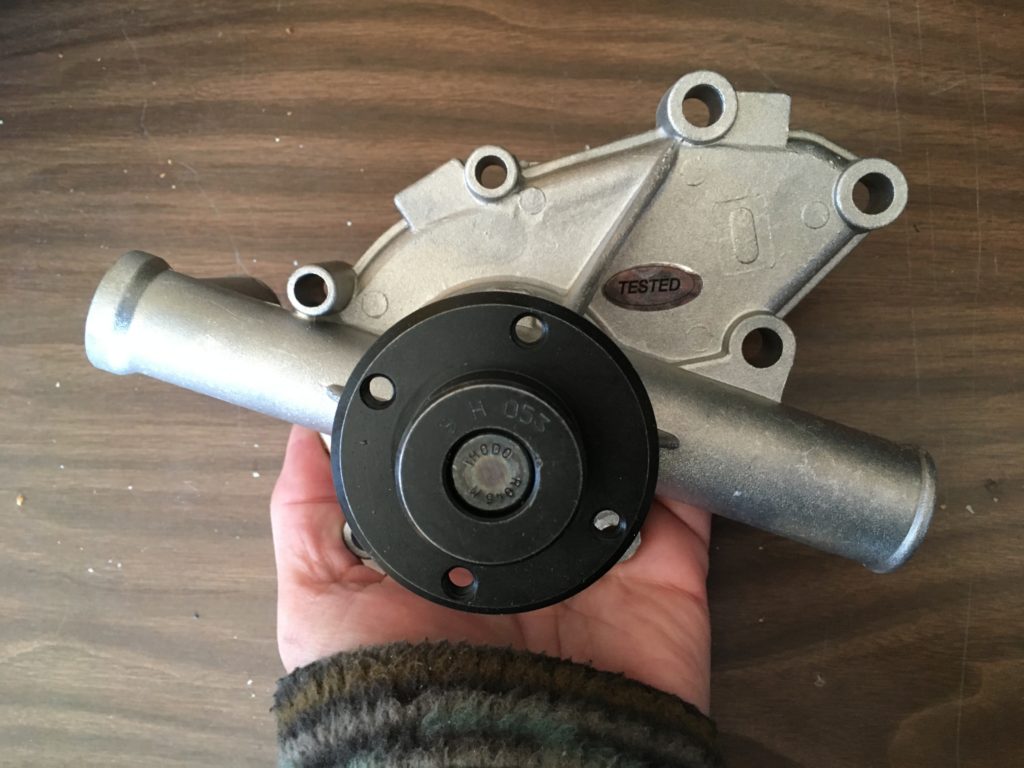
Ick.
I took Justin Gerry up on his recommendation and spoke with Wade at Flying Dutchman. He said that he rebuilds 2002tii water pumps all the time, and charges about $130 plus shipping (note that tii water pumps are available from BMW, but they’re rebuilt as well, and the list price is over $400). Wade said that since regular 2002 water pumps are available new and inexpensively through the aftermarket, he’d never had a request to rebuild one, but understood completely when I explained the car’s originality and low mileage.
It was a funny and surprising turn of events. I am completely unapologetic about being relentlessly cost-conscious with my cars; as I keep saying, I own twelve cars, and not one of them will ever get everything it needs, much less all of them. There’s just not enough money in my life—and that’s okay. I’d rather operate that way than not have the twelve cars, and I don’t really give a rat’s patootie what anyone thinks about my individual penny-pinching decisions. If one of them bites me in my patootie, then I learn from it (maybe) and don’t make the same mistake again (usually).
I’ll admit that, left-brain-wise, with Hampton’s low mileage and good condition, part of me felt that, clearly, spending $150-ish on not only a BMW water pump with the correct date code, but what’s likely the original BMW water pump would burnish the car’s survivor status enough that I’d make the $150 back. But that only came after intending to install that Graf pump, when my right brain literally stopped me, screaming, “Dude! Barf! You’re going to hate yourself if you see this thing attached to that engine.” (My right brain, apparently, is Sean Penn in Fast Times At Ridgemont High. Who knew?)
So: Hampton’s original water pump is winging its way westward to Wade (sorry, couldn’t resist). In about two weeks I should have it back, and all the molecules in Hampton’s engine can resume vibration at a common frequency.
Next I need to decide whether to install that unused “Genuine BMW” under-hood insulation I bought for Kugel, the ’72 tii I sold last spring, only to balk at the fact that it looked like it teleported in from the wrong century and put it on the shelf. On the other hand, it sounds like I already know the answer to that one.—Rob Siegel
Rob’s new book, Resurrecting Bertha: Buying Back Our Wedding Car After 26 Years In Storage, is available on Amazon here. His other books, including his recent Just Needs a Recharge: The Hack MechanicTM Guide to Vintage Air Conditioning, are available here on Amazon. Or you can order personally-inscribed copies of all of his books through Rob’s website: www.robsiegel.com.

